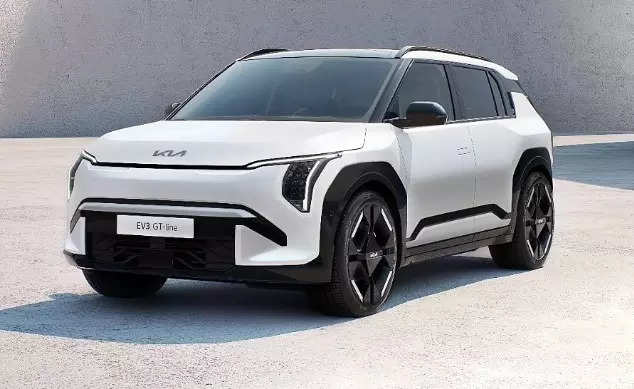
New Delhi: Kia has unveiled EV3, its compact electric SUV (ESUV), marking its fourth EV release after the EV9, EV6, and EV5. It comes in two trim levels, the standard version with a 58.3kWh battery pack, and the long-range edition (up to 600km on WLTP cycle) with an 81.4kWh battery pack.
After the launch in the home market it will be available globally. India entry is expected in 2025.
Built upon the E-GMP modular platform shared with its larger counterparts, it retains the family design ethos while incorporating advanced interior technology and features inherited from its pricier siblings.
Exterior Design
At the front, the Kia EV3 gets vertical headlamps positioned at the extremes of the facial area. A new interpretation of Kia’s tigerface design incorporates the brand’s latest star map signature lighting concept. The Daytime Running Lights (DRLs) are positioned vertically.
Kia highlights the benefits of the slightly sloping roofline and prominent rear spoiler for enhancing aerodynamic efficiency, along with the aero-optimized wheels featuring a distinctive block-like design. The rear design resembles the EV9, featuring a robust dual-tone bumper and sleek surfacing for the tailgate. Additionally, GT-Line variants of the EV3 offer sportier bumpers. The EV3’s dimensions measure 4,300mm in length, 1,850mm in width, 1,560mm in height, with a wheelbase of 2,680mm, similar to that of a Hyundai Creta
Kia offers the EV3 in nine body colors – two of which have been created exclusively for the new model: Aventurine Green and Terracotta.
Kia EV3 interior
The interior of the Kia EV3 mirrors the sleek design of its larger counterpart, the EV9. The dashboard boasts a familiar layout, featuring twin 12.3-inch floating infotainment screens. Below these screens, a strip of haptic buttons seamlessly blends in, alongside discreetly integrated AC vents. Navigation and media controls are easily accessible, with additional buttons conveniently located on the two-spoke steering wheel. Notably, the EV3 inherits its impressive 30-inch widescreen setup, which includes a dedicated 5-inch screen for climate controls, directly from the EV9.
The EV3 flaunts the hallmark packaging perks of a true-born EV, boasting a flat floor that maximizes interior space. Its design incorporates a spacious floating center console equipped with cup holders, while the front center armrest conceals a convenient retractable table. Moreover, the driver’s seat offers a ‘relaxation mode,’ enabling passengers to fully stretch out and indulge in their preferred streaming platforms or video games via the infotainment unit while the vehicle recharges.
Kia emphasizes the utilization of sustainable materials throughout the EV3’s interior, including seats and roof lining crafted from recycled PET bottles, biowaste integrated into the paint and dashboard, and exterior cladding composed of recycled plastic from earlier Kia models.
In terms of features, the EV3 showcases a 12-inch heads-up display, customizable ambient lighting, and advanced digital displays, complemented by a premium Harman Kardon sound system and an ADAS suite for enhanced safety. Notably, the EV3 introduces Kia’s pioneering personal AI assistant, slated for gradual implementation across other EV models. With a spacious 460-liter trunk and an additional 25-liter frunk for added storage capacity, the EV3 promises practicality.
Power and battery capacity
Built on the E-GMP platform, the Kia EV3 offers two battery choices. The standard version is equipped with a 58.3kWh battery pack, while the Long-Range edition comes with an 81.4kWh battery pack. Both the models feature a front-axle mounted electric motor delivering 201hp and 283Nm of torque, resulting in a claimed 0-100kph acceleration time of 7.5 seconds. The EV3 achieves a top speed of 170kph.
Kia has disclosed that the Long-Range variant can cover up to 600km on the WLTP cycle. The batteries, sourced from LG Chem and operating on a 400V architecture, can charge from 10% to 80% in 31 minutes. On the other hand, the flagship EV9 boasts of an 800V EV architecture, along with vehicle-to-load (V2L) capabilities and paddle shifters for regenerative braking.
















